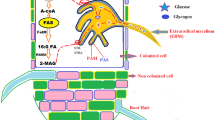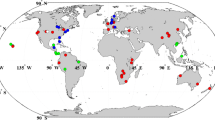Abstract
Ecosystem net CO2 uptake, evapotranspiration (ET) and night-time CO2 efflux were measured in an alpine grassland dominated by Carex curvula, treated with doubled ambient partial pressure of CO2 via open-top chambers. One quarter of the plots were treated with mineral nutrients to simulate the effect of lowland nitrogen deposition rates. Depending upon fertilizer supply, ecosystem net CO2 uptake per ground area in full sunlight (NCEmax) was 41–81% higher in open-top chambers supplied with doubled ambient partial pressure (p a) of CO2 than in plots receiving ambient CO2. Short-term reversals of the CO2 level suggest that the extent of downward adjustment of canopy photosynthesis under elevated CO2 was 30–40%. ET tended to decline, while water use efficiency (WUE), expressed as the NCEmax:ET ratio, increased more than twofold under elevated CO2. Night-time ecosystem CO2 efflux did not respond to changes in CO2 p a. NCEmax and night-time CO2 efflux were more responsive to mineral fertilizer than the doubling of CO2. This suggests that in these alpine plant communities, atmospheric nutrient input may induce equal or greater effects on gas exchange than increased CO2.
Similar content being viewed by others
References
Bazzaz FA (1990) The response of natural ecosystems to the rising global CO2 levels. Annu Rev Ecol Syst 21:167–196
Bowman WD, Theodose TA, Schardt JC, Conant RT (1993) Constraints of nutrient availability on primary production in two alpine tundra cummunities. Ecology 74:2085–2097
Curtis PS, Drake BG, leadley PW, Arp WJ, Whigham DF (1989) Growth and senescence in plant communities exposed to elevated CO2 concentrations on an estuarine marsh. Oecologia 78:20–26
Diaz S, Grime JP, Harris J, McPherson E (1993) Evidence of a feedback mechanism limiting plant response to elevated carbon dioxide. Nature 364:616–617
Drake BG, Leadley PW (1991) Canopy photosynthesis of crops and native plant communities exposed to long-term elevated CO2. Plant Cell Environ 14:853–860
Drake BG, Arp WJ, Balduman L, Curtis PS, Johnson J, Kabara D, Leadley PW, Pockman WT, Seliskar D, Sutton ML, Whigham D, Ziska L (1989) Effects of elevated carbon dioxide on Chesapeake Bay wetlands. IV. Ecosystem and whole plant responses, April–November 1988 (Report no. 51) U.S.Department of Energy, Carbon Dioxide Research Division, Office of Energy Resources, Washington, DC
Fajer ED, Bazzaz FA (1992) Is carbon dioxide a ‘good’ greenhouse gas? Global Environ Change 2:301–310
Field CB, Ball JT, Berry JA (1991) Photosynthesis: principles and field techniques. In: Pearcy RW, Ehleringer J, Mooney HA, Rundel PW (eds) Plant physiological ecology. Chapman and Hall, New York, pp 209–253
Field CB, Chapin FS III, Matson PA, Mooney HA (1992) Responses of terrestrial ecosystems to the changing atmosphere: a resource-based approach. Annu Rev Ecol Syst 23:201–235
Eamus D (1991) The interaction of rising CO2 and temperatures with water use efficiency. Plant Cell Environ 14:843–852
Eamus D, Jarvis PG (1989) The direct effects of increase in the global atmospheric CO2 concentration on natural and commerical temperate trees and forests. Adv Ecol Res 19:1–47
Grulke N, Riechers GH, Oechel WC, Hjelm U, Jaeger C (1990) Carbon balance in tussock tundra under ambient and elevated atmospheric CO2 Oecologia 83:485–494
Kelliher FM, Leuning R, Schulze E-D (1993) Evaporation and canopy characteristics of coniferous forests and grasslands. Oecologia 95:155–163
Körner Ch (1982) CO2 exchange in the alpine sedge Carex curvula as influenced by canopy structure, light and temperature. Oecologia 53:98–104
Körner Ch (1993) CO2 fertilization: the great uncertainty in future vegetation development. In: Solomon AM, Shugart HH (eds) Vegetation dynamics and global change. Chapman and Hall, New York, pp 53–70
Körner Ch, Arnone JA III (1992) Responses of elevated carbon dioxide in artificial tropical ecosystems. Science 257:1672–1675
Körner Ch, Diemer M (1987) In situ photosynthetic responses to light, temperature and carbon dioxide in herbaceous plants from low and high altitude. Eunct Ecol 1:179–194
Körner Ch, Diemer M (1994) Evidence that plants from high altitude retain their greater photosynthetic efficiency under elevated CO2. Funct Ecol 8:58–68
Körner Ch, Wieser G, Cernusca A (1989) Der Wasserhaushalt waldfreier Gebiete in den österreichischen Alpen zwischen 600 und 2600 m Höhen. In: Cernusca A (ed) Struktur und Funktion von Graslandökosystemen im Nationalpark Hohe Tauern. Veröff. österr. MaB Progr. 13. Universitätsverlag Wagner, Innsbruck, pp 119–153
Körner Ch, Diemer M, Schäppi B, Zimmermann L (1994) The response of alpine vegetation to elevated CO2. In: Mooney HA, Koch GW (eds) Terrestrial ecosystem response to elevated CO2. Physiol Ecol Ser. Academic Press, London (in press)
Kuhn U, Oser R (1991) Verfahren zur Messung kleiner Drosselquerschnittsflächen. Bosch Tech Ber 53:33–39
Long SP, Hallgren J-E (1985) Measurement of CO2 assimilation by plants in the field and in the laboratory. In: coombs E, Hall DO, Lang SP, Scurlock JMO (eds) Techniques in bioproductivity and photosynthesis, 2nd edn. Pergamon Press, Oxford, pp 62–94
Nijs I, Impens I, Behaeghe T (1989) Leaf and canopy responses of Lolium perenne to long-term elevated atmospheric carbon-dioxide concentrations. Planta 177:312–320
Oechel WC, Riechers G, Lawrence WT, Prudhomme TI, Grulke N, Hastings SJ (1992) “CO2LT” an automated, null-balance system for studying the effects of elevated CO2 and global climate change on unmanaged ecosystems. Funct Ecol 6:86–100
tissue DT, Oechel WC (1987) Response of Eriophorum vaginatum to elevated CO2 and temperature in the Alaskan tussock tundra. Ecology 68:401–410
Tyree MT, Alexander JD (1993) Plant water relations and the effects of elevated CO2: a review and suggestions for future research. Vegetatio 104/105:47–62
Zar JH (1984) Biostatistical analysis, 2nd edn. Prentice Hall, Englewood Cliffs
Author information
Authors and Affiliations
Rights and permissions
About this article
Cite this article
Diemer, M.W. Mid-season gas exchange of an alpine grassland under elevated CO2 . Oecologia 98, 429–435 (1994). https://doi.org/10.1007/BF00324233
Received:
Accepted:
Issue Date:
DOI: https://doi.org/10.1007/BF00324233




